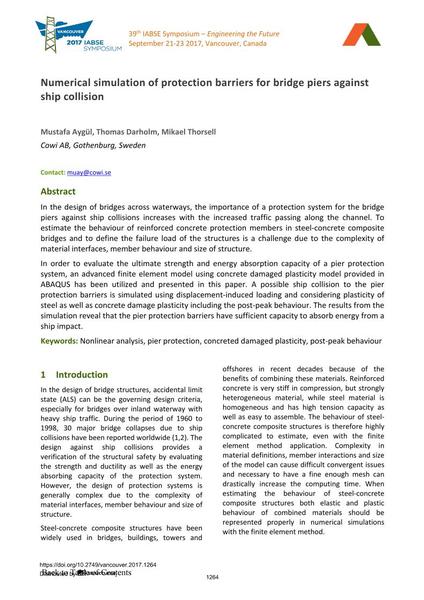Numerical simulation of protection barriers for bridge piers against ship collision

|
|
|||||||||||
Détails bibliographiques
| Auteur(s): |
Mustafa Aygül
(Cowi AB, Gothenburg, Sweden)
Thomas Darholm (Cowi AB, Gothenburg, Sweden) Mikael Thorsell (Cowi AB, Gothenburg, Sweden) |
||||
|---|---|---|---|---|---|
| Médium: | papier de conférence | ||||
| Langue(s): | anglais | ||||
| Conférence: | IABSE Symposium: Engineering the Future, Vancouver, Canada, 21-23 September 2017 | ||||
| Publié dans: | IABSE Symposium Vancouver 2017 | ||||
|
|||||
| Page(s): | 1264-1273 | ||||
| Nombre total de pages (du PDF): | 10 | ||||
| Année: | 2017 | ||||
| DOI: | 10.2749/vancouver.2017.1264 | ||||
| Abstrait: |
In the design of bridges across waterways, the importance of a protection system for the bridge piers against ship collisions increases with the increased traffic passing along the channel. To estimate the behaviour of reinforced concrete protection members in steel-concrete composite bridges and to define the failure load of the structures is a challenge due to the complexity of material interfaces, member behaviour and size of structure. In order to evaluate the ultimate strength and energy absorption capacity of a pier protection system, an advanced finite element model using concrete damaged plasticity model provided in ABAQUS has been utilized and presented in this paper. A possible ship collision to the pier protection barriers is simulated using displacement-induced loading and considering plasticity of steel as well as concrete damage plasticity including the post-peak behaviour. The results from the simulation reveal that the pier protection barriers have sufficient capacity to absorb energy from a ship impact. |
||||
